Will IBM Verse make you more productive than before?
Tuesday, May 12th, 2015If you use eProductivity or have some interest in it, head over to Inside.eProductivity for the details: click here.
Worth your time
- Nätcasino Utan Svensk Licens
- Siti Scommesse Non Aams
- Non Gamstop Casinos
- Casino Sites Not On Gamstop
- Casino Sites Not On Gamstop
- UK Casinos Not On Gamstop
- I Migliori Casino Online
- Casino Non Aams
- Casino Sites UK
- UK Casino Not On Gamstop
- Casino En Ligne
- Non Gamstop Casino UK
- Non Gamstop Casino
- Non Gamstop Casino
- Non Gamstop Casino UK
- Casino Sites Not On Gamstop
- Non Gamstop Casinos
- Casino En Ligne Meilleur Site
- Meilleur Casino En Ligne Avis
- Gambling Sites Not On Gamstop
- UK Casino Sites Not On Gamstop
- Gambling Sites Not On Gamstop
- Non Gamstop Casino
- Casino Sites Not On Gamstop
- Migliori Casino Italiani Online
- Meilleur Casino En Ligne En Belgique
- Casino Con Prelievo Visa
- Meilleurs Site De Paris Sportif
- русские букмекерские конторы
- Crypto Bookmaker
My 1st step to close out the year: Shred your lists!
Wednesday, December 24th, 2014My favorite way to get energized for the holidays is to look back on what I've accomplished this year.
Unless you keep your whole world in your head, you've got a list somewhere of what to do. Now is a great time to take that list (or collection of lists) and tear it to pieces! -- after you've reviewed its contents, that is.
As you look back on your old lists, you'll find four kinds of stuff
- Stuff you need to finish
- Stuff you'd like to do someday
- Stuff you're not going to do
- Stuff you've already finished!
Here's how to deal with each one. Along the way, you'll make two clean, shiny, new lists to work from in 2015.
Stuff to finish
First of all, don't panic. If this is well and truly something you must get done by a certain deadline, here's what to do:
- Think about the very next thing you need to do to accomplish this
- Put that very next thing on your list (not the list you're reviewing, but your brand spanking new New Year's list)
Take one step at a time, and you will get it done.
If you're using eProductivity, make a new Project (or update the old one). You're one step closer to a fresh new year.
Stuff for someday
You could, should, or would do this, but right now you don't have the time, resources, knowledge, or deadline. What do you do with these?
Get ready for a high-tech term:
"Someday/Maybe"
This is not:
- A black hole where things go to die
- Your procrastinate list
- For stuff you'll never actually do
This is your list for things you want to do, but can't or shouldn't right now.
If you're using eProductivity, this comes built-in. Just look on the left!
Stuff not to do
Let's face it: you will never actually do this. It's time to recognize that, cross it off, and move on. Shred it, delete it, crumple it up -- it's not going to stress you anymore.
Stuff you've finished!
Read your list and realize, "I did that. I'm finished. It's done." Just soak in that accomplishment.
The feeling you got when you actually finished it was the sundae -- crossing it off your list is the cherry on top.
In eProductivity, just click the handy "Mark Complete" button. It's not shaped like a cherry, but it should be.
Smell that fresh, clean New Year
Once you're done, your trash is full, your desk is clean, and your lists are fresh. You are one organized captain of your work world. Now go have a happy holiday -- you've earned it!
(Hint: all these steps work just as well for your personal stuff!)
Over the next few days, I will share 3 more tips to help you wrap up the year. Meanwhile, I wish you the happiest of holidays!
Eric
Part 2: Review your future conversations | Part 3: Get inspired with your creative ideasHow I make smarter choices and feel better about how I use my time
Tuesday, February 18th, 2014Have you ever asked yourself, "self, why did I waste my time in that way?"
I've done both. Many times.
As I continue to do research in high performance knowledge work and personal knowledge management, I've collected a number of tools and methods to help me make smarter decisions about what to do or not do.
Today, I'd like to share one of those tools with you. I call it my opportunity decision matrix,
When I was in graduate school and trying to run my consulting business and launch a software company and be a loving husband and father to my four daughters, I hit a wall. Something had to give. But what?
My good friend, Michael, gave me some sage advice that helped a lot. He told me to ask myself two simple questions to ask whenever I needed to evaluate options.
Here's how this works:
First define the "opportunity". Perhaps it's "Attend ABC conference". Next, evaluate that opportunity through the lens of two filters: opportunity and timing, like this:
Question #1. Is this the right opportunity?
If it isn't, stop. Don't waste your time. Done. Decision made. If it is the right opportunity, then, I continue to question #2
Question #2. Is this the right timing?
Many times, I have a right opportunity but bad timing. It makes no sense to proceed unless both the opportunity and timing are right.
I have since expanded into an this 2x2 opportunity decision matrix:
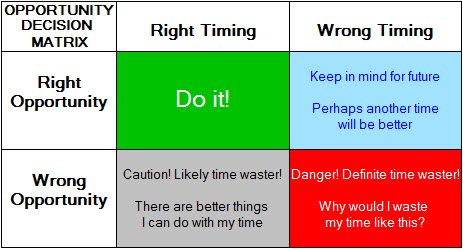
This matrix has proven extremely valuable to me when I have a lot of hard choices to make and a new one shows up (like, "hey, do you want to fill in the blank.... ?")
For example, at a particularly busy point in my life, I got invited to speak at a conference. It was a great opportunity and I really wanted to go. However, it was not the right timing, so I declined. Having this simple two question matrix really helped me make a hard decision easy.
The following year I was invited to speak at a different event. I concluded that it was both the right opportunity and the right timing, so I accepted the invitation and the "Beyond Planning Conference" was born.
Sometimes, when it seems like I have many large or complex decisions to make, It helps me to pull out a sheet of paper and make a 4x4 matrix, like the one above. Then, I list of all of the options on my plate and one by one, and I write them into the appropriate quadrant.
It's usually quite a sobering experience.
Next, I cross off everything in quadrants 3 & 4 and move quadrant 2 items to my "someday/Maybe" list. This leaves me with only my quadrant 1 items, which I do.
By being ruthless in evaluating all of my choices against these two criteria, I can get unstuck quickly and feel good about the choices I make.
How do you make choices? What tools have you found helpful to make decisions?
Deja Office for Lotus Notes - Part 2
Wednesday, January 8th, 2014I created a new test document on the iPhone and synched it over to notes. I made sure to choose a category for this test document, and was pleased to find that when I replicated with Notes, my test memo appeared and was correctly categorized.
 However, I was away from my computer yesterday and needed to capture some information into my Reference Database. I pulled out my iPhone and quickly created a new Deja Office memo. The information I was recording fell under two categories in my reference database, so as I was adding the category, I chose two categories, everything looked fine, so I saved the memo and double checked that it was recorded in Deja Office - no problem so far.
However, I was away from my computer yesterday and needed to capture some information into my Reference Database. I pulled out my iPhone and quickly created a new Deja Office memo. The information I was recording fell under two categories in my reference database, so as I was adding the category, I chose two categories, everything looked fine, so I saved the memo and double checked that it was recorded in Deja Office - no problem so far.  It was not until I synched Daja Office with Lotus Notes that I noticed the problem. I replicated Notes, then went to my Reference Database and opened the category I had filed the memo under to find the memo. To my surprise, I could not locate the memo under either of the categories I had filed it in, nor could I find it in my uncategorized view. It was not until I searched under "All Documents" that I located my entry. It appears that Deja Office had created a new, invisible category that was a combination of the two categories I entered. This new category does not appear as a category on the left side of my screen.
It was not until I synched Daja Office with Lotus Notes that I noticed the problem. I replicated Notes, then went to my Reference Database and opened the category I had filed the memo under to find the memo. To my surprise, I could not locate the memo under either of the categories I had filed it in, nor could I find it in my uncategorized view. It was not until I searched under "All Documents" that I located my entry. It appears that Deja Office had created a new, invisible category that was a combination of the two categories I entered. This new category does not appear as a category on the left side of my screen. This is a big problem for me as I often have entries that use multiple categories. I would love to see a solution for this.
Deja Office for Lotus Notes
Saturday, January 4th, 2014 Our company recently purchased several iPhone 5c's for testing purposes and I spent a good portion of the day setting up my phone and testing various productivity solutions to see how well they integrate with eProductivity. I set up Lotus Traveler to synchronize my email, contacts, and calendar. Next, I set up the IBM Traveler Tasks application and the IBM Traveler Companion App I was disappointed to learn that IBM Traveler does not provide a solution for the IBM Notes Notebook as this is a key element in any personal information management (PIM) system. I use my Notes Notebook as my go to Reference Database. The Reference Database is a key tool in my toolbox and I find myself using it on my smartphone on a regular basis.
Our company recently purchased several iPhone 5c's for testing purposes and I spent a good portion of the day setting up my phone and testing various productivity solutions to see how well they integrate with eProductivity. I set up Lotus Traveler to synchronize my email, contacts, and calendar. Next, I set up the IBM Traveler Tasks application and the IBM Traveler Companion App I was disappointed to learn that IBM Traveler does not provide a solution for the IBM Notes Notebook as this is a key element in any personal information management (PIM) system. I use my Notes Notebook as my go to Reference Database. The Reference Database is a key tool in my toolbox and I find myself using it on my smartphone on a regular basis. Continue Reading "Deja Office for Lotus Notes" »
How old were you when you first started using Lotus Notes?
Friday, January 28th, 2011 Recently in the news, Microsoft has been bragging about how schools are either currently using or switching to Microsoft Outlook. While that is true for most schools, our school, the Mack Academy has always used Lotus Notes and has made it an integral part of our school productivity toolkit.
Recently in the news, Microsoft has been bragging about how schools are either currently using or switching to Microsoft Outlook. While that is true for most schools, our school, the Mack Academy has always used Lotus Notes and has made it an integral part of our school productivity toolkit. Our principal realized the value of technology in the schools and started training us how to use computers at a very young age. In fact, I was two when my sister Amy and I were introduced to Lotus Notes and when I received my first email!
Continue Reading "How old were you when you first started using Lotus Notes?" »
Tungle App for BlackBerry
Sunday, January 23rd, 2011 As a follow-up to last week's blog post on Tungle for Lotus Notes, I decided to venture out today and install the Tungle application for my BlackBerry.
As a follow-up to last week's blog post on Tungle for Lotus Notes, I decided to venture out today and install the Tungle application for my BlackBerry. The installation process went very smoothly, so much so that I am not going to document the steps here. I simply downloaded the free application from my BlackBerry App World, and, once loaded, I followed the instructions Tungle provides to set up this app.
 What this application allows me to do is to initiate and respond to Tungle invitations from my BlackBerry, without ever having to log onto the web to schedule a meeting. I am very pleased so far with everything I have seen and I am excited to continue using Tungle. For those of you trying to hurriedly schedule your meetings for Lotusphere, this should be a great help to you.
What this application allows me to do is to initiate and respond to Tungle invitations from my BlackBerry, without ever having to log onto the web to schedule a meeting. I am very pleased so far with everything I have seen and I am excited to continue using Tungle. For those of you trying to hurriedly schedule your meetings for Lotusphere, this should be a great help to you.PCWorld mentions Lotus Notes and eProductivity
Tuesday, October 26th, 2010The closing section of the article features tips from recognized productivity experts such as David Allen, who happens to be a long-time passionate champion of Lotus Notes and eProductivity.
The article had this to say:
Allen is a Lotus Notes enthusiast, through and through, but he enhances the spartan Notes interface with the eProductivity add-on, which adds next-generation features to the software. One of these features, for example, enables the user to drag an e-mail message to a "call" button in order to place an immediate phone call to the person who sent the message.
David Allen also mentioned ActiveWords (which integrates seamlessly with eProductivity) and MindManager as being among his favorite tools.
Hat tip to Ed Brill.
Getting Things Done with Lotus Notes - Episode #6
Thursday, September 16th, 2010People often ask us to share what productivity tools we use. In episode #6, we talk about the tools we use in the areas of:
- Information Management
- Visualization & Planning
- Mobile Productivity
- Rapid Capture
- Navigation
- GTD Implementation
Following the discussion, we answer a number of questions from the audience. This is a long podcast, so I decided to break it up into four parts for easier listening.
Episode #6 of Getting Things Done with Lotus Notes - The Podcast
Hey Gmail, Lotus Notes did it first
Thursday, September 2nd, 2010I’ve been reading the many articles on the new Gmail Priority Inbox with great interest. People are praising this “innovative” Gmail feature all over the place. And it is pretty cool. But as Alan Lepofsky pointed out, Lotus Notes has had similar inbox categorization features for over a decade. But apparently, few people know that. Or maybe, few people care…
The Lotus Notes categorized inbox provides many of the features that everyone is raving about in Gmail’s release. In Notes, your inbox can sort emails according to high priority marks, calendar invites, and the unwashed masses of regular emails. It’s helpful. If you’re a person who receives critical calendar invites interspersed with stacks of regular emails, it can be a life-saving feature.
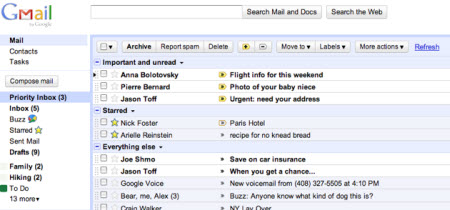
Source: TechCrunch
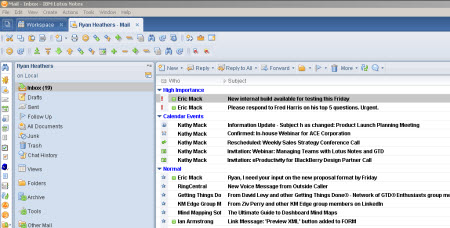
The one feature that the Gmail Priority Inbox provides that’s unique is the learning algorithm that trains itself to know what emails are most important to you. But I can see the value of this feature swinging all over the place. The jury is still out on whether Gmail can accurately predict what's important to me.
Continue Reading "Hey Gmail, Lotus Notes did it first" »
Is it Actionable or is it Reference?
Friday, June 25th, 2010A key question to ask yourself when processing your stuff (emails, papers, etc) is "is this Actionable or is this Reference?" By separating your stuff into "Actionable" and "Reference" piles, you can keep your productivity system neat and tidy.
Some quick definitions:
- Actionable: anything that requires your attention
- Reference: Items that do not require your action, but you want to keep on hand
It's not enough to ask this important question alone. A key to making this separation work is having a place to park your reference material. For that purpose, the Lotus Notes Notebook (formerly called the Lotus Notes Personal Journal) is a great tool. And, it's built in to Lotus Notes.
Here's a screenshot of one of my Notebooks:
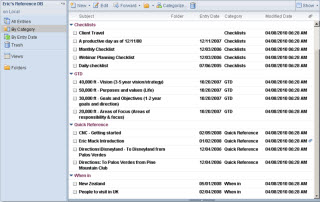
You can see that my Notebook has all sorts of valuable stuff in it. But because it's stored away from my email inbox and my To Do lists, I only have to think about my Reference items when I choose to - they're not hitting me in the face while I'm trying to work on projects.
Check out the Lotus Notes Notebook. If you want to take your reference filing to the next level, go get yourself a download a free eProductivity Reference template that you can use to upgrade your Notes Notebook.
IdeaJam: Productive and Innovative
Monday, July 13th, 2009On the business side of the house, we rely on a number of productivity tools, and most of them them aren't our own. One of the tools in our toolkit is IdeaJam, by Elguji. IdeaJam makes it possible for our customers to have a voice in the feedback and design process. It simply works. IBM knows this and has awarded the Elguji team with a reception on Times Square. Well done, team Elguji!
Podcast: An Inside Look at ActiveWords
Friday, July 10th, 2009Kelly Forrister recently posted a new podcast on the GTD Times blog featuring David Allen and Buzz Bruggeman of ActiveWords discussing the productive benefits of ActiveWords:
One of the tools David Allen uses on his PC is ActiveWords, a tool often described as “solving a problem you didn’t know you had.” It essentially streamlines the navigation and common tasks we do all day long; send emails, go to web sites, create new tasks, insert text, open files and more...
When it comes to saving time in daily tasks in Windows, ActiveWords delivers. And you can learn more about how it does that by listening to the podcast linked below.
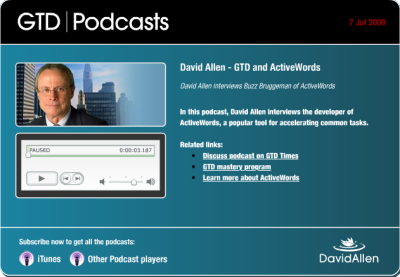
Did you know that ActiveWords fully integrates with Lotus Notes and eProductivity in some especially cool ways? In fact, at around the 15:30 mark of the podcast, David and Buzz discuss combining ActiveWords and eProductivity to create a supercharged productivity system.
Here's how to install ActiveWords with Lotus Notes and eProductivity.
(Includes a 60-day free trial of ActiveWords)
Two useful tools for your productivity toolbox SNTT
Thursday, July 9th, 2009Find the long file names on your drives
Find and fix erroneous file names on your drive
These two tools do what their names say and I've already found them indispensable to help me locate file and folder names that were either too long or that contained characters that would cause my backup software to choke.
These tools have now earned a place in my productivity tool box
Both of these tools are from Proud Programmer, Rovert Ibsen Voith and can be downloaded for free from Voith's Code.
Video: How to use ActiveWords
Monday, June 29th, 2009I've just posted the video and related links over on the inside.eProductivity blog.
Since this blog is focused primarily on Lotus Notes, I know that the next question I will get is: "Will ActiveWords work with Lotus Notes?"
Yes and no.
ActiveWords works as if you had typed keystrokes at your keyboard and is great for launching applications and substituting text. These features work great in Notes.
Because Lotus Notes is itself a windowed application ActiveWords has not context from which to control specific features of Notes once launched. This is because it has no context.
For people that use eProductivity for Lotus Notes we have modified Notes in such a way that ActiveWords can effectively control most aspects of Notes. So, for example, I can type "IN" anywhere (Notes does not even have to be running) and ActiveWords will launch Notes (if not already open) and take me to my inbox.
Even without the connection to Lotus Notes, I think ActiveWords is a remarkable application and certainly one I am never without!
ActiveWords Web site
When tools (e.g. Lotus Notes) become personal
Thursday, June 25th, 2009Ed Brill: What kind of apps do you run on the Notes client stand-alone?
Eric Mack: Just what is Lotus Notes good for, anyway?
There's discussion about what people use Notes for and whether it can be personal or not. I just posted this comment to Ed Brill's blog, but I think it is valuable to re-post here. It deals with the issue that when tools become personal, people become passionate about them - and they tell their friends, and their friends, and their friends...
@12, one of my clients, David Allen, loves to show end-users and senior company execs the Notes Journal - something most have no idea exists. If you have ever attended his Getting Things Done (GTD) seminars, you know that he often mentions and shows how he uses Lotus Notes and then he talks about the power of the journal and the ability to customize. 10 years ago (it maybe more) David stumbled on the Notes Designer client and created his own quote application - an app then he still uses and shows off today.The key point I want to make is:The key here is that Notes became personal to him. Once a tool becomes personal, people can't help but tell and show their friends. Think of the iPhone.
When tools become personal, people become passionate about them - and they tell their friends, and their friends, and their friends...
In this illustration, and end-user "discovered" something that created great value for him (the Notes Journal) and then he "discovered" that he could customize the way he works with his information using the Notes designer client. the tool became personal. Now, you couldn't pry it from his hands. I know many people that feel the same way.
As I teach in my seminars: "for tools to become productive, they have to become personal."
What do YOU think?
How to save MS Office docs in ODF format (LS09 Tip)
Thursday, December 4th, 2008How to quickly convert your LS09 presentation to ODF from PPT
The deadline for submitting the Lotusphere 2009 presentations is tomorrow. IBM added a new twist this year by requiring that all presentations be created in Symphony. While I appreciate the intent behind the request -- to get everyone using and showing Symphony -- it may not be a practical solution for everyone. I'm all for learning Symphony, but if I have to choose between working on my presentation deck for Lotusphere or learning Symphony so that I can convert my PowerPoint slides to it, guess which I'll choose?
I pinged Stephan Wissel over this and, after some ribbing about why I've not yet converted to Symphony (I know, shameful, but I plan to, soon), he told me about a plug-in from Sun Microsystems that will ODF-enable Microsoft Office:
- The ODF Plug-in seamlessly integrates with the Load and Save As dialog and the Save (Ctrl+S) shortcut of Microsoft Office Word.
- A new toolbar in Microsoft Office Excel and Microsoft Office PowerPoint simplifies the import and export of ODF documents.
- Make the ISO standardized OpenDocument file format the standard in your company, and switch the standard file format in Microsoft Office Word to ODF.
Here's a link to the Sun ODF Plug-in for Microsoft Office
My Bold First Impressions of BlackBerry 9000 Bold
Thursday, November 27th, 2008
I've had the Bold for just 24 hours, long enough to collect my thoughts and first impressions. Here's my 24-hour report card:
| Setup/Operation | EXCELLENT |
| Device Design | EXCELLENT |
| Screen/Keyboard | EXCELLENT |
| Use of standard connectors | EXCELLENT |
| Voice Call/Quality/Volume | VERY GOOD |
| Size/Weight | EXCELLENT |
| Navigation/Ease of Use | EXCELLENT |
| AT&T Coverage & Network (so far) | VERY GOOD |
| WiFi Integration | EXCELLENT |
| BlackBerry as Modem | POOR |
| BlackBerry Desktop Software | VERY GOOD |
| Task Management | POOR |
| Overall Satisfaction | VERY GOOD |
Some of you may disagree with my POOR ratings. I wanted to capture my first impressions. I will continue to test and evaluate these and other features of the Bold offering. I simply wanted to capture my first impressions.
Continue Reading "My Bold First Impressions of BlackBerry 9000 Bold" »






